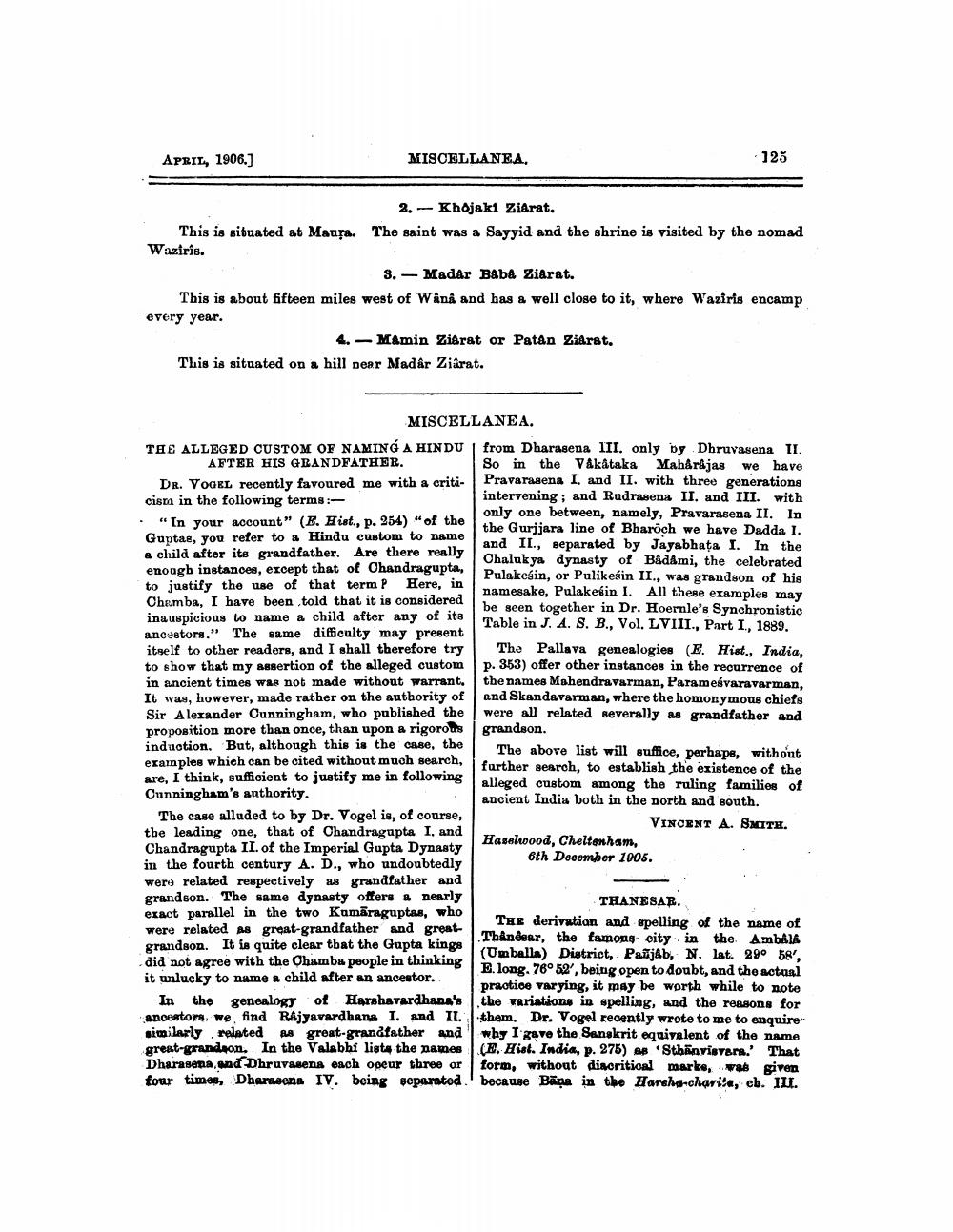________________
APRIL, 1906.]
MISCELLANEA,
125
2.- Khojaki Ziarat. This is situated at Maura. The saint was a Sayyid and the shrine is visited by the nomad Waziris.
3. - Madár Baba Ziarat. This is about fifteen miles west of Wanâ and has a well close to it, where Waziris encamp every year.
4.- Mamin Ziarat or Patan Ziarat. This is situated on a hill Dear Madár Ziarat.
MISCELLANEA.
TAE ALLEGED CUSTOM OF NAMING A HINDU from Dharasena III. only by Dhruvasena IL AFTER HIS GRANDFATHER.
So in the Vákataka Maharajas we have DR. VOGEL recently favoured me with a criti- Pravaraaena I. and II. with three generations cism in the following terms :
intervening; and Rudrasena II. and III. with
only one between, namely, Pravarasena II. In . "In your account" (E. Hist., p. 254) "of the
the Gurjjara line of Bharoch we have Dadda I. Guptae, you refer to a Hindu custom to name
and ILseparated by Jayabhata I. In the a child after its grandfather. Are there really
Chalukya dynasty of Badami, the celebrated enough instances, except that of Chandragupta,
Pulakesin, or Pulikesin II., was grandson of his to justify the use of that term P Here, in
namesake, Pulakesin I. All these examples may Chemba, I have been told that it is considered
be seen together in Dr. Hoernle's Synchronistic inauspicious to name a child after any of its
Table in J. A. S. B., Vol. LVIII., Part I., 1889. ancestors." The same difficulty may present itself to other readers, and I shall therefore try The Pallava genealogies (E. Hist., India, to show that my assertion of the alleged custom p. 353) offer other instances in the recurrence of in ancient times was not made without warrant, the names Mahendra varman, Parameśvaravarman, It wag, however, made rather on the authority of and Skandavarman, where the homonymous chiefs Sir Alexander Ounningham, who published the were all related severally as grandfather and proposition more than once, than upon a rigorous grandson. induction. But, although this is the case, the
The above list will suffice, perhaps, without examples which can be cited without much search,
further search, to establish the existence of the are, I think, sufficient to justify me in following
alleged custom among the ruling families of Cunningham's authority.
ancient India both in the north and south. The case alluded to by Dr. Vogel is, of course,
VINCENT A. SMITH. the leading one, that of Chandragupta I. and
Hassiwood, Cheltenham, Chandragupta II. of the Imperial Gupta Dynasty
6th December 2005. in the fourth century A. D., who undoubtedly were related respectively as grandfather and grandson. The same dynasty offers a nearly
THANESAR. exact parallel in the two Kumāraguptas, who
The derivation and spelling of the name of were related as great-grandfather and greatgrandson. It is quite clear that the Gupta kings
Thåndear, the famous city in the AmbAlA
(Umballa) District, Pažáb, N. lat. 29° 58', did not agree with the Chamba people in thinking
E. long. 78° 52', being open to doubt, and the actual it unlucky to name a child after an ancestor.
practioe varying, it may be worth while to note In the genealogy of Harshavardhana's the variations in spelling, and the reasons for ancestors, we find Rajyavardhana I. and IL.them. Dr. Vogel recently wrote to me to enquirer similarly related A great-grandfather and why I gave the Sanskrit equivalent of the name great-grandion. In the Valabhí list the names (1). Hist. India, p. 275) ap Sthiinvisvara.' That Dharasena, and Dhruvasena each opeur three or form, without dinoritioal marke, was given four times, Dharasena IV. being separated because Bāna in the Harsha charita, cb. III.




